People are drawn to Wildcat Den State Park for its history, geology, and botany. Thanks to the efforts of early settlers, areas of mature, undisturbed forest still exist in the park along Pine Creek. Most of Wildcat Den State Park is natural forest spread across a diverse landscape. Several steep sloped ravines separate the higher elevations on the west side from the lower areas to the east. The variety of landforms creates an environment that supports over 300 species of plants including the rare oval ladies’-tresses orchid and many species of ferns.
The Pine Creek Grist Mill is the jewel of the park area. Construction began on the structure in 1848 and it operated as a functioning business until 1927. Public works programs in the 1930’s help save the derelict structure and today the Pine Creek Grist Mill is maintained as a fully functional mill thanks to volunteers associated with Friends of Pine Creek Grist Mill. Tours are offered to watch the old technology in action. Be sure to visit the nearby Melpine Schoolhouse that has been restored.
One of the most striking features at Wildcat Den State Park is the exposed sandstone bluffs. The bluffs provide dramatic overlooks of the forest and Pine Creek Valley below. Geological formations have been eroded from the sandstone and are fun places to explore. Exposed limestone and shale can be seen in the lowest elevations along Pine Creek.
Campground
There are 28 primitive camping sites situated in an open area of the forest. The campground is surrounded by trees, however sites have minimal shade. Each camp area is level and grassy with a fire ring and picnic table. Campers have access to non-modern restrooms and water spigots. The trailhead in the campground is a short distance from Devil’s Punch Bowl and Horseshoe Bend.
If you’re not a fan of the primitive camping then try the modern campground facilities at Fairport Recreation Area five miles away or West Lake Park fifteen miles away.
Printable Trail Map
Trails
The 4.2 mile trail at Wildcat Den State Park is a lollipop type with a couple tributary trails. The signature geologic features are east of 181st Street and as a consequence the trails can have more traffic. The west side of the park tends to have fewer hikers making it easy to enjoy a quiet hike through a dry forest dominated by mature White and Red Oaks.
A popular way to start hiking is to park in the lot near the Pine Creek Grist Mill on the east side of the park. From there, you cross Wildcat Den Road to the trailhead. As you head west the trail ascends 93 feet in first .4 miles. At the first intersection you can go left to Devil’s Punch Bowl and Horseshoe Bend or right to The Dens, Devil’s Alley, Steamboat Rock, and Fat Man’s Squeeze.
– Devil’s Punch Bowl and Horseshoe Bend
Horseshoe Bend was created by a small unnamed tributary of Pine Creek that has undercut the sandstone to create a concave erosion feature. The erosion looks similar to what you would see in the slot canyons of the southwest United States. Nearby is a large bowl shape area called Devil’s Punch Bowl. The bowl was formed when sediment laden water poured over from the bluff above. To get a different perspective, climb the wooden staircase for views of the area from above Devil’s Punch Bowl.
The glen that contains these two features is a good spot to explore, photograph or simply linger. In addition to the sandstone formations the glen provides a unique microenvironment for a variety of plants.
– Devil’s Alley, Fat Man’s Squeeze and Steamboat Rock
Near the picnic loop is a massive piece of the bluff that broke away called Steamboat Rock. The space between the original bluff and the Steamboat Rock is called Devil’s Alley. Hike up Devil’s Alley to find a narrow passage in Steamboat Rock called Fat Man’s Squeeze. You can walk all the way around Steamboat Rock to investigate the rugged terrain. This area is one of the best outdoor playgrounds around.
– The Dens
Two dens that formed in the side of a weathered sandstone cliff are open for visitors to explore. Wildcat Den and the smaller Bobcat Den are located near the Emma and Clara Brandt Plaque. Once at the plaque, look for stairs in the rock that lead up to Wildcat Den. Bobcat Den is about a hundred feet to the north.
Final Impressions
I’m always surprised by the natural wonders in Iowa’s modest sized parks. The glen that features Devil’s Punch Bowl and Horseshoe Bend is fascinating to explore and was my favorite place in the park. If I lived nearby, I would hike the western trail frequently to enjoy the solitude of a forest walk.
I was also impressed by the industrial archeology that went into restoring the Pine Creek Grist Mill. The meticulous efforts of volunteers to rebuilding the mill have created a mechanical sculpture that is a memorial to Iowa’s settlement.









Excellent read, I’m going to visit Wildcat Den for sure. I had no idea that a Mill like that existed here in Iowa…
Thanks
Excellent Bob – let me know what you like about the park. 🙂
We’re lived near Buffalo, Iowa for 19 years now, and had no idea this park was a good place to visit. I drove through it today and will plan to come back for a hike very soon.
By the way, your County and Nearest City at the top of this page are incorrect for Wildcat Den.
Thanks Robb – I’ve updated the information.